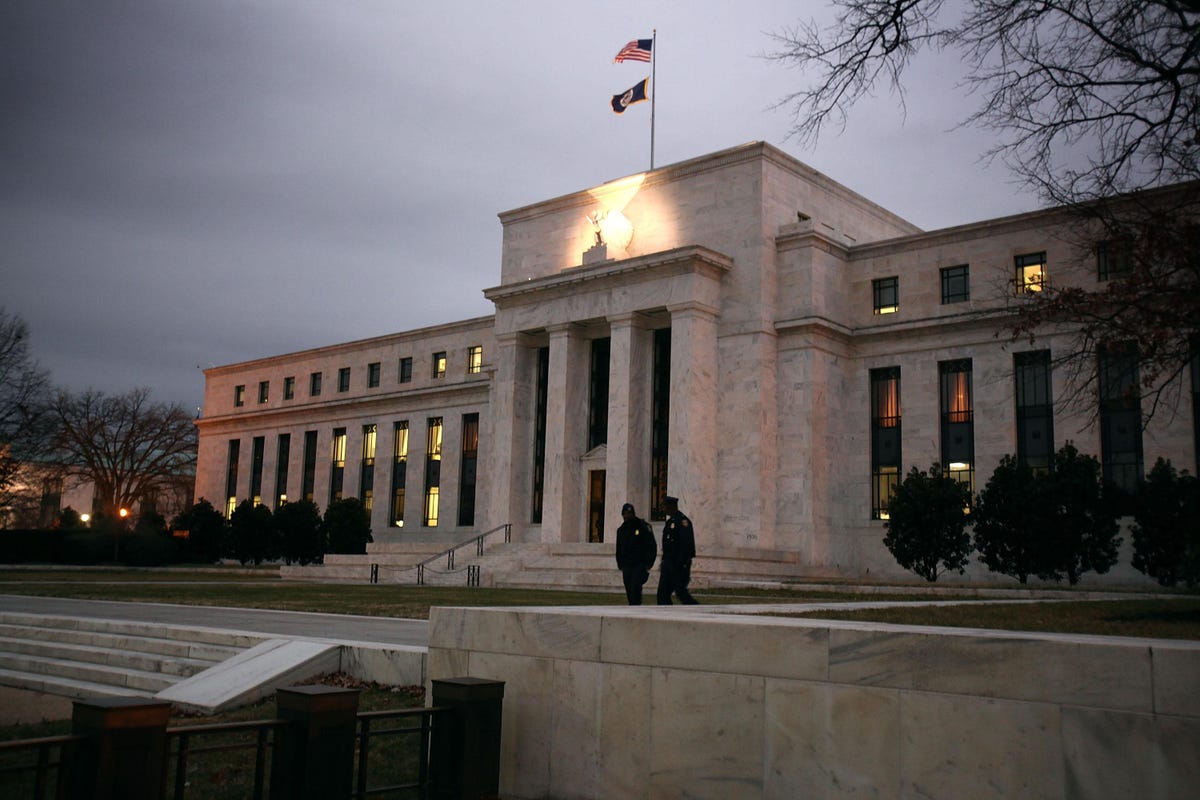[ad_1]
“Banks and networks have faked real-time by creating a real-time experience even if it is not gross settlement in real-time,” said Jennifer Lucas, EY Americas payments consulting leader.
Banks and some payment providers have made payments appear to be real-time because they provide good funds to the recipient even before the payments settle — that’s the way Zelle and Venmo work, although some Zelle payments settle in real-time through The Clearing House (TCH) real-time network (RTP), while others settle through traditional and slower ACH.
The Federal Reserve was slow to launch its own real-time payments network. (Photo by Mark … [+]
“It’s difficult for consumers to understand why payments are not real-time today,” said Lucas. “They can get toothpaste delivered in a couple of hours, why does it take a day or a couple of days, for payments, and why does it take longer for some payments than others?”
But now, she says, she sees a lot of investment in making payments real-time end to end.
“Instead of faking it, we are seeing settlement in real-time so the risk and liability associated with the float or faking the real-time experience goes away. Regardless of rail, regardless of the digital channel in which it was initiated, the experience will be real-time for the customer. The settlement side is catching up to benefit merchants and corporations on the settlement side, although it has taken longer to get to ubiquity than some had predicted.”
But often the delays in settlement are not seen by consumers.
“Consumers don’t care about settlement between the parties. We have created these perceived real-time experiences. As a consumer I don’t care how the money actually moves, if I can get access to it and use it like it was cash in my bank account.”
Lucas takes a rather benign view of the way banks have rolled out real-time payments.
Financial institutions invested in RTP without any outside force telling them they should, she said.
“In the U.S. there is not a mandate authority, we don’t have a central authority that says all banks will do X by Y. We enjoy a lot of choice. A lot of financial institutions participate in the ecosystem. It’s a really big country with a lot of diversity.”
Getting an infrastructure to get reach thousands of banks without a central authority creates a lot of complexity and self-determination, she added.
The U.S. has lagged behind other countries in developing real-time — the UK had Faster Payments a decade before the U.S. The delay were partly because of resistance by the big banks.
Kevin Wack, national editor at American Banker, has covered the issue for years and wrote a 2019 summary of the evolution of real-time payments in the U.S. after a lobbyist for the big banks accused the Federal Reserve of backtracking on a promise to defer to the private sector. (Editors at American Banker pointed me to Wack’s reporting going back to 2012 while I was covering the Fed’s conferences on real-time payments.)
“Before they built their own real-time payment system, the nation’s big banks were skeptics of faster payments. In 2012, they torpedoed a plan to enable speedier payments on the automated clearing house network, though a revised version of it was later enacted.”
In a 2013 paper TCH warned of the dangers of a payments monopoly.
“After The Clearing House launched the RTP Network, however, it backed away from concerns about the dangers of a monopoly, Wack wrote. “The Clearing House has recently argued that the Fed should remain on the sidelines in part because technical challenges in achieving interoperability would slow the adoption of real-time payments. Interoperability would enable a payment to be initiated on one of two systems and completed on the other.”
The Fed was slow to decide to develop a real-time payments network, although smaller banks and credit unions that commented on a draft proposal several years ago almost all called for a Fed network.
Kevin notes that a Fed statement was “putting the central bank in an indecisive posture that it has maintained for several years now.”
An August article in the Wall Street Journal in August gave an estimate of the costs of the delays.
“Aaron Klein, a senior fellow at the Brookings Institution, said the Fed’s slowness in setting up FedNow—the project has been in the works for more than seven years—has cost consumers hundreds of billions in the form of overdraft fees, check-cashing fees and late fees,” wrote Andrew Ackerman.
Before launching RTP The Clearing House said it would charge all financial institutions the same price, and requested an antitrust review by the Department of Justice which offered its approval. But in April 2019, Wack writes, “The Clearing House added a large caveat to its earlier pledge: Its commitment to charge the same prices to banks of all sizes will apply only as long as it is the sole U.S. operator of a real-time payment system.”
Now that real-time payments are here, or almost here, banks are increasingly looking at RTP to expand their business in specific verticals, such as auto finance, payroll, logistics, travel, and health care, Lucas said. Banks that want to expand their lending can attract business by showing they can deliver a loan in real time.
EY papers on real-time payments suggest that banks and payment service providers should also look for overlay services, such as request to pay, account to account payments and innovative cross-border payments.
The consultancy expects tech firms, PayTechs in EY lingo, to play a big role.
“PayTechs are already at the forefront of RTP technology. In order to retain or even increase their market share, they must offer their solutions to banks and non-banks, continue to leapfrog legacy organizations with customer-centric experiences and wrap their services with established risk management and fraud controls.”
Some EY recommendations may be due for an update.
“Notably, all payments providers are starting to recognize the potential of digital assets, cryptocurrencies and DLT technology to help improve and transform clearing and settlement processes,” the consultancy wrote in an October report, “How the rise of PayTech is reshaping the payments landscape.”
That, of course, was before crypto imploded.
[ad_2]
Source link






